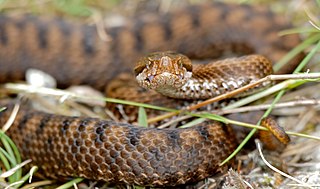
Cerrophidion is a genus of pit vipers which are endemic to southern Mexico, Central America, and western Panama. The generic name, Cerrophidion, is derived from the Spanish word cerro, which means "mountain", and the Greek word ophidion, which means "small snake". Five species are recognized as being valid, but no subspecies are.

Vipera aspis is a viper species found in southwestern Europe. Its common names include asp, asp viper, European asp, and aspic viper, among others. Like all other vipers, it is venomous. Bites from this species can be more severe than from the European adder, V. berus; not only can they be very painful, but approximately 4% of all untreated bites are fatal. The specific epithet, aspis, is a Greek word that means "viper." Five subspecies are currently recognized, including the nominate subspecies described here.

Snakes, like other reptiles, have skin covered in scales. Snakes are entirely covered with scales or scutes of various shapes and sizes, known as snakeskin as a whole. A scale protects the body of the snake, aids it in locomotion, allows moisture to be retained within, alters the surface characteristics such as roughness to aid in camouflage, and in some cases even aids in prey capture. The simple or complex colouration patterns are a property of the underlying skin, but the folded nature of scaled skin allows bright skin to be concealed between scales then revealed in order to startle predators.

Isla Escudo de Veraguas is a small (4.3 km2) isolated Caribbean island of the Republic of Panama. Despite its name, it is not part of the province of Veraguas, but rather Bocas del Toro. The island is located about an hour away from Rio Caña, an Indigenous Ngäbe-Buglé community that is part of a recently established tourism network in Panama.

Serranía de Los Churumbelos Auka-Wasi National Natural Park was declared on 30 August 2007 by the Colombian government. It is located in the Bota Caucana of southern Colombia. Three biological expeditions conducted rapid biodiversity surveys and conservation assessments in Serranía de los Churumbelos from 1998 to 2000. The results from the expeditions were published by Fundacion ProAves in Conservacion Colombiana in 2007. These studies raised interest in the region and laid the justification for the protection of this spectacular mountain range.
Xenopeltis hainanensis is a non-venomous sunbeam snake species found in China and Vietnam. This is a primitive snake known for its highly iridescent scales. No subspecies are recognized.

Overexploitation, also called overharvesting, refers to harvesting a renewable resource to the point of diminishing returns. Continued overexploitation can lead to the destruction of the resource, as it will be unable to replenish. The term applies to natural resources such as water aquifers, grazing pastures and forests, wild medicinal plants, fish stocks and other wildlife.
Aipysurus duboisii, also known commonly as Dubois' sea snake and the reef shallows sea snake, is a species of extremely venomous snake in the subfamily Hydrophiinae of the family Elapidae. Its geographic range includes Papua New Guinea, New Caledonia and the northern, eastern and western coastal areas of Australia, that is the Coral Sea, Arafura Sea, Timor Sea and Indian Ocean. It lives at depths up to 80 meters in coral reef flats, sandy and silty sediments which contain seaweed, invertebrates and corals or sponges that can serve as shelter. It preys upon moray eels and various fish that live on the seafloor, up to 110 cm in size. A. duboisii is viviparous, giving birth to live young rather than laying eggs. It displays medium aggressiveness, i.e., will bite if provoked, but not spontaneously. The fangs are 1.8 mm long, which are relatively short for a snake, and the venom yield is 0.43 mg. Aipysurus duboisii is a crepuscular species, meaning that it is most active at dawn and dusk.

The La Amistad International Park, or in Spanish Parque Internacional La Amistad, formerly the La Amistad National Park, is a transboundary protected area in Latin America, management of which is shared between Costa Rica and Panama, following a recommendation by UNESCO after the park's inclusion in the World Heritage Site list in 1983. The park and surrounding biosphere reserve is one of the most outstanding conservation areas in Central America, preserving a major tract of tropical forest wilderness. It is world-renowned for its extraordinary biodiversity and endemism.

Paedophryne amauensis, also known as the New Guinea Amau frog, is a species of microhylid frog endemic to eastern Papua New Guinea. At 7.7 mm (0.30 in) in snout-to-vent length, it is considered the world's smallest known vertebrate.
Mining and hydroelectric projects in Panama are heavily discussed topics in Panama due to several laws for the protection of the native inhabitants and the neo-liberal plans of the government. Since the beginning of 2011 large protests against such mining and hydroelectric projects have been held by the indigenous inhabitants of Panama.

Diasporus is a genus of frogs in the family Eleutherodactylidae. The genus was first described in 2008. They are found in Central and northern South America. They are sometimes referred to as dink frogs, in reference to the "tink" sound that males make during the mating season.

Barro Blanco is a gravity dam on the Tabasara River in the Chiriqui Province of Panama. It began generating in 2017 with capacity of 28.56 MW. Although the government had authorized the dam, it suspended construction in February 2015 after protests. The President of the Republic authorized the partial restart of construction in August 2015, but prohibited the filling of the reservoir pending a final agreement. Important issues concerning the dam are controversial, such as the question whether the indigenous communities in the area initially had expressed their support or their opposition to the dam's construction and how well they had been informed about the project and its impacts prior to expressing their views.

Sibon is a genus of snakes found in northern South America, Central America and Mexico.

L. J. Mendis Wickramasinghe is a Sri Lankan herpetologist, taxonomist, naturalist, and wildlife photographer. Inspired by a childhood passion on snakes and by the diversity of his motherland, he has spent over two decades experiencing the forests across Sri Lanka.
Anolis datzorum is a species of lizard in the family Dactyloidae. The species is native to Central America.
Ecnomiohyla bailarina, the golden-eyed fringe-limbed tree frog, is a frog in the family Hylidae, endemic to Panama and Costa Rica. Scientists have seen it between 400 and 1400 meters above sea level. It lives in the Talamanca Mountains in Costa Rica and in Santa Fé National Park in Panama.
Ecnomiohyla veraguensis is a frog that lives in Costa Rica and Panama. Scientists have seen it at 540 meters above sea level. It lives in the Talamanca Mountains in Costa Rica and in Santa Fé National Park in Panama.
Uropeltis bhupathyi, commonly known as the Bhupathy’s shieldtail, is a species of snake in the family Uropeltidae. The species is endemic to the Western Ghats in southern India.

Sibon irmelindicaprioae is a species of nonvenomous snake in the subfamily Dipsadinae. It is endemic to Panama. It was discovered by Ecuadorian biologist Alejandro Arteaga and Panamanian biologist Abel Batista in 2023. Sibon irmelindicaprioae belongs to the genus Sibon, and subfamily Dipsadinae. It is also called DiCaprio’s snail-eating snake.












